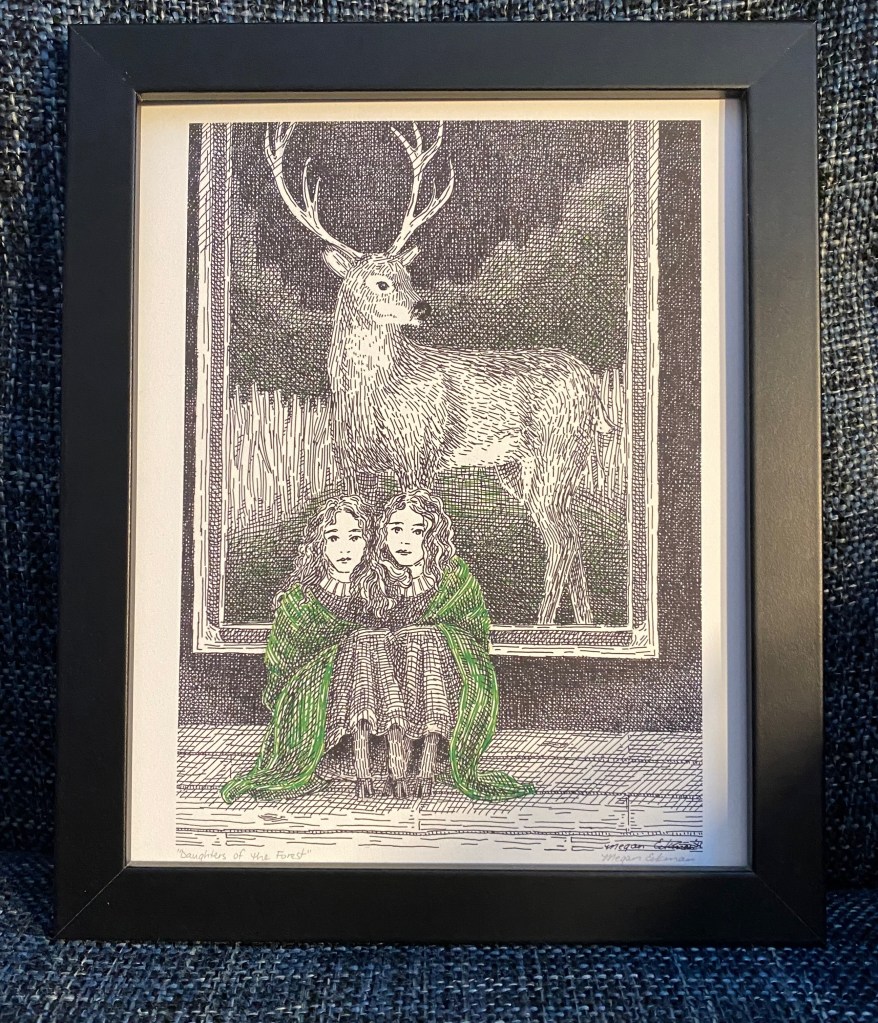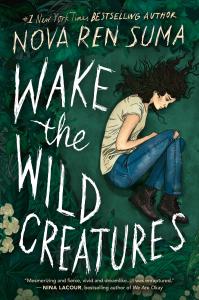1 Author, 7 Questions: Nova Ren Suma
Nova Ren Suma is the author of vivid, moving, and lyrical novels including The Walls Around Us and A Room Away From the Wolves. Reading a Nova Ren Suma book is an experience like no other, and I recommend her work to all my friends! I had the fantastic opportunity to sit down with Nova and talk about her latest book Wake the Wild Creatures, and we even got a little glimpse into what she might be working on next!
What was your initial inspiration for Wake the Wild Creatures?
The first glimmer of an idea for Wake the Wild Creatures came to me because a friend and fellow writer gave me a birthday present. This was Libba Bray, the brilliant author of so many books I love. She gifted me with a pen-and-ink drawing called “Daughters of the Forest” by an artist named Megan Eckman. What I noticed first in the image were the two almost identical girls in dresses—sisters, maybe—and behind them a peek of forest. A deer with antlers stands there, gazing on. Then I looked closer and noticed a detail I hadn’t caught: the girls’ feet poking out beneath their dresses aren’t human feet. They’re deer hooves. It was this moment of surprise that set my imagination flying, and the picture became a writing prompt for me. The idea shifted and transformed as I kept writing, and two daughters of the forest in my imagination became one, but I love knowing a whole novel originated from this piece of art.
If you’re curious, here’s the picture:

[“Daughters of the Forest” by Megan Eckman]
Do you see story possibilities in it too?
Can you describe your writing process? Are you more of a pre-plotter of do you let the plot develop as your write?
In recent years I’ve become a discovery writer. Meaning I’ll write ahead with an open mind for a long period of drafting. Only when I’ve explored and meandered and spent time digging around (and making generous use of character-focused writing prompts!) would I have enough pieces of the story to start making conscious plot choices and getting a whole draft down. But I’d sometimes curse myself for being so slow and uncontained. And I think it’s important to stretch yourself as a writer and try new methods for each new book, so with the novel I’m working on now I’ve allowed myself some time to discover… but I’ve also offered myself ways to do more early planning. I’m trying to sketch out a structure, build some signposts to keep me from wandering too far off-course, and allow leaps forward to help me envision the end. Ask me again later how this change in my process worked out!

The way the Neves operates as a collective feels so different from the way much of our society functions. Where did you draw your inspiration from?
The people of the Neves—the community at the top of the mountain where my protagonist, Talia, has grown up—believe in making decisions by consensus and refuse to elect one leader who rules over everyone else. I’ve had some experience with small communities and with collective decision-making, and I respect this way of living without authority and without hierarchy, even as I recognize that the active work of it isn’t easy. With Wake the Wild Creatures, I wanted to write about one small community of women and girls that’s trying to create something different for themselves. There are problems that arise in the story, of course—what engaging plot can exist without problems?—but with the Neves, I wanted to speak to the idea of building something new when greater society has let you down. And I also wanted to speak to rebuilding when things are broken, but are very much still worth fixing.
Parts of Talia’s narration blur the line between reality and fantasy. How do you approach writing those more magical moments? Where is that line between fantasy and reality?
I love writing about magic in the real world, and reading about it all the more. I’m especially drawn to moments when the magic gets blurry and you’re not entirely sure what you’re meant to believe. This novel is told closely through Talia’s eyes, and she sees her home of the Neves as a protected place, guarded by a mysterious mist that allows only those who are meant to be there to find it. She discovered this as a child and her belief in this protective barrier has never wavered. Now, is this a true fact? In writing the world of this story, I needed to be so closely tied to Talia that her belief was as real to me as the ground she walks on. Her gaze made the magic come alive for me, and I wrote it with that on my mind. But if a reader comes away with a different interpretation, I would never dissuade them from it. For me, the line between fantasy and reality is always unsteady, sometimes twisty and tentacled and misleading, and I believe is best left open to a reader’s interpretation. When I was growing up, I very much saw the world in this unreliable way: as if adults were insisting it was one way, but whenever they weren’t looking and it was me alone with my overactive imagination, I could see what they couldn’t. Something wondrous. Something other. Something they’d call impossible but, to me, was just as real… maybe. I want my books to feel like that.

The support Talia and Lake come to give one another is really moving. What do you think are some of the ways we can really show up for the people in our lives when they need us most?
One of my favorite parts of writing this book was how Talia and her cousin Lake began to recognize each other in surprising ways. They start the book as antagonists—Lake, especially, appears to treat Talia with open disdain, and Talia is sure to keep her distance, feeling unwanted. But the subtext between them is far more complicated, and softer than either realize. Their scenes together speak to forming an at first reluctant sisterhood, and to the complexities and tensions and bonds of female friendship. In the book Talia and Lake become allies, which happened organically as I was writing but wasn’t what I had planned originally. It felt important to me to show the ways to help a friend through trauma, to do so without judgment, without telling them what they should do, by listening, by supporting, by, as this question states, showing up. Talia and Lake both find themselves facing moments like this, for each other.
What are some books you’ve been reading recently, or would recommend?
I’m very interested in stories that show sides of the world I haven’t seen, through a look at mythic history or through a glimpse into a possible precarious future. The Lost Queen by Aimee Phan brings legends of ancient Vietnam to urgent life through the meeting of two reincarnated sisters in modern-day San Jose, and I was completely swept away by it. Sea Change by Susan Fletcher is a near-future reimagining of “The Little Mermaid” in the midst of climate catastrophe, and I found myself both haunted by the worldbuilding and touched by the glimmers of hope within. I read Parables of the Sower by Octavia Butler for the very first time recently, and was shaken by it and transformed. The book I just finished is The Dream Hotel by Laila Lalami, and it was ominous, important, and inspiring.
What are you working on now? Any exciting ideas or projects you can share?
When I’m in the early stages of writing a new novel, I need to hold it very close and not let anyone know too much, or it could dissipate in a puff of smoke and leave me confused and wondering what happened. But what I can tell you is this: It’s very strange… and it’s scaring me a little. To me, those two very specific ingredients make it the best kind of project to explore.
This extraordinary, timely, and must-read novel from #1 New York Times bestselling author Nova Ren Suma explores freedom and rage as a young woman plots her way back to her hidden mountaintop home after her mother’s arrest for murder.
Three years ago, Talia lived happily in the ruins of the Neves, a once-grand hotel in the wilds of the Catskill Mountains, with her mother Pola and their community of like-minded women. Some came to the Neves to escape cruel men, others to hide from the law, but all found safety and connection in their haven high above civilization, cloaked by a mysterious mist that kept intruders away. But as their numbers grew, complications followed, and everything came crashing down the night electric lights pierced the forest. Uniformed men arrested Pola, calling her a murderer and a fugitive, and Talia was taken away.
Now sixteen, Talia has been forced to live with family she barely knows and fit into a world scarred by misogyny, capitalism, disconnection from nature . . . everything the women of the Neves stood against. She has one goal: to return to the Neves. But as Talia awaits a signal from her mother, questions arise. Who betrayed her community, and what is she avoiding about her own role in its collapse? Is it truly magic that keeps the hotel so hidden? And what does it mean to embrace being her mother’s daughter? With the help of an unexpected ally, Talia must find her way to answers, face a mother who’s often kept her at arm’s length, and try to reach the refuge she lost—if the mist hasn’t swallowed her path home.
Fierce and lyrical, unsettling and tender, Wake the Wild Creatures marks the long-awaited return of one of the most distinctive voices in young adult literature.






